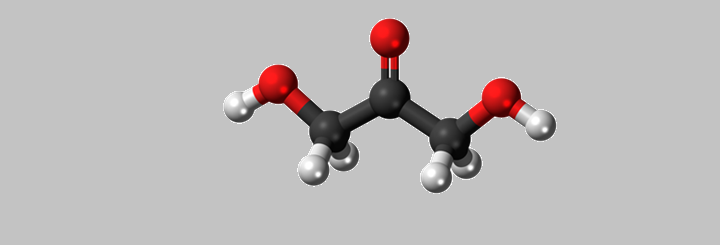INTRODUCTION
1,3-Dihyrdoxyacetone is a hygroscopic, white powder with a minty odor. It is abundantly found in nature as derivative of starch and is an intermediate product of fructose metabolism. Acronymed as DHA, it is at large used in the cosmetic industry.
The sunless tanning industry has experienced rapid growth due to public education on the dangers of ultraviolet radiation on skin and improvements in products. Dihydroxyacetone (DHA) is a 3-carbon sugar allowed by the Food and Drug Administration (FDA) as a color additive in sunless tanning products.
Manufacture
DHA is manufactured by bacterial fermentation of glycerine and alternatively from formaldehyde using formose reaction.
| Synonyms | Chromelin Glycerone 1,3-Dihydroxypropan-2-one |
| CAS no. | 96-26-4 |
| EINECS no. | 202-494-5 |
| Molecular formula | C3H6O3 |
| Molecular weight | 90.08 |
| Structure |  |
| Applications in Medicine |
|---|
| The ketone has a history of medical application. It was used in 1950’s as an oral drug to treat children with glycon storage disorder. |
| Applications in Cosmetics |
|---|
| As skin conditioning agent |
| As reducing agent |
| As tanning agent |
| Applications in Intermediates |
|---|
| DHA is a KRM for manufacture of intermediates including but not limited to: |
| a) Hydroxypyruvic acid b) 1-(4-methylbenzyl)-1H-5-hydroxymethyl-imidazole c) 4-Imidazolemethanol HCl d) Glyceric acid e) DL-Glyceraldehyde f) Mannose g) DL-Arabinose |
| Other Applications |
|---|
| Chromelin is also used as color additive |
| DHA is also reported to be used in winemaking |
SPECIFICATIONS
| Test | Unit | Specifications |
|---|---|---|
| Appearance | – | White or off-white powder |
| pH | – | 4.0 – 6.0 |
| Moisture | % | Max 0.40 |
| ROI | % | Max 0.40 |
| Heavy metals | ppm | Max 10.0 |
| Iron as Fe | ppm | Max 25.0 |
| Arsenic | ppm | Max 3.0 |
| Assay | % | Min 98.0 |
STORAGE
The product is stored at ambient temperature.
PACKING
25 kg drum.
REACH Status
Under registration.
ExSyn offers DHA on commercial scales and welcomes enquiries. No matter the quantity you need, our exceptional quality and service will make ExSyn your supplier of choice! If you need any additional information or SDS, please contact us.
Iodine is anon-metallic, dark-grey/purple-black, lustrous, solid element. It is the heaviest and the rarest of stable halogens that can be found on the crust of earth.About fifty percent of all iodine produced and manufactured worldwide is used to form Organoiodine compounds. Iodine is an important element for many health-sustaining processes and essential for human thyroid health.
The product, acronymed Oct-NBE, is an organic compound with a cyclic ring system and a 8-membered hydrophobic chain. The structure renders the chemical special properties leading to its applications in diverse fields.
Nicotine is a hygroscopic, colorless to slight yellow, oily liquid, that is readily soluble in alcohol, ether or light petroleum. It is widely used recreationally as a stimulant and anxiolytic.
The product, acronymed ETD, is an organic compound with a fused bicyclic ring system and an ethylidene group. The structure renders the chemical special properties leading to its applications in diverse fields.
Sodium perchlorate monohydrate is the inorganic compound with the chemical formula NaClO4•H2O. It is the common existence form of sodium perchlorate, which can gradually absorb water in the air to form the monohydrate. Sodium perchlorate monohydrate is white rhombic crystal which is highly soluble in water and in alcohol. Its capacity to undergo redox reactions, liberating oxygen atoms, has been harnessed in the preparation of specialty chemicals, including pharmaceutical intermediates and fine chemicals.
Triphenylphosphine is a common organophosphorus compound that is frequently abbreviated as PPh3 or Ph3P. It is widely used in organic and organometallic compound synthesis because it is an effective reducing agent as well as a neutral ligand. At room temperature, PPh3 crystals are relatively air-stable and colourless.
Potassium chlorate holds significant importance across various industries due to its diverse applications. This white crystalline compound has been utilized for centuries as an essential ingredient in the production of matches, fireworks, and explosives, owing to its ability to release oxygen upon decomposition.
Podophyllotoxin is a non-alkaloid toxin lignan extracted from the roots and rhizomes of Podophyllum species. It is an organic heterotetracyclic compound that has a Furonaphthodioxole skeleton bearing a 3,4,5-trimethoxyphenyl substituent.
Octadecylphosphonic acid (ODPA), a versatile chemical compound, serves as a surfactant and dispersant in applications spanning coatings, lubricants, and corrosion inhibition. With its hydrophobic octadecyl chain linked to a phosphonic acid group, it excels in surface modification, boosting adhesion in metal surfaces.
